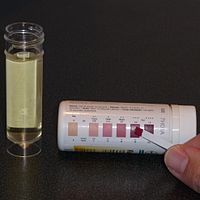
Photo from wikipedia
Misperceptions on the chance of seizure freedom with antiseizure medications after two failed trials To the Editors:Kwan and Brodie's landmark article1 was a significant step in our understanding of refractory… Click to show full abstract
Misperceptions on the chance of seizure freedom with antiseizure medications after two failed trials To the Editors:Kwan and Brodie's landmark article1 was a significant step in our understanding of refractory epilepsy. The long-term data2 and the work of others have helped to confirm that about one third of people with epilepsy will continue to have seizures despite the use of antiseizure medications (ASMs). However, the way the results were reported has led to persistent confusion over the implications for the care of individual patients. This article is commonly cited as demonstrating that the chance of seizure freedom after failing two ASMs is 5% or less; this is wrong. This misperception has become so common that it has even been included in the work of highly respected academics in prestigious journals.3–6 A recent advertisement for a vagus nerve stimulator attached to the cover of Epilepsy Currents, the official journal of the American Epilepsy Society, stated that “after two medications have failed, the chance of a third medication failing is 95%.” This error prompted us to write this letter to help dispel the myth. The 5% number comes from the data that <5% of the total study cohort achieved at least 1 year of seizure freedom with additional drug trials after failing the first two ASMs. This is misleading when considering the impact on individual patients. As reported in the most recent follow-up study,2 the percent of patients who became seizure-free when undergoing a third drug trial after failing two prior ones was 23.6%. Even the sixth ASM trial led to seizure freedom in 14% (6 of 43). Other recent work has supported this conclusion. One study found that 31% of 403 patients ≥16 years of age having failed at least two ASMs due to inefficacy were in continuous seizure freedom for at least 1 year at the end of the observation period.7 Similarly, a prospective trial of adults with focal epilepsy showed that 11.8% (per protocol) to 17.4% (intention to treat) became seizure-free with the third ASM trial.8 This should not diminish the importance of early referral to a comprehensive epilepsy center after failing two ASMs for definitive diagnosis and to begin evaluation for potentially curative epilepsy surgery, as early surgery in carefully selected patients has been proven to be dramatically more effective than continued medical treatment for obtaining seizure freedom.9 Our concern is that the use of this misleading statistic when promoting alternatives to ASMs serves to discourage continued medication trials. The rates of long-term seizure freedom with neurostimulation therapies are <20%; thus in nonlesional, multifocal, or otherwise less-than-ideal surgical candidates, additional ASM trials may be advised before surgery. More concerning would be promoting a sense of nihilism, leading patients and clinicians to abandon further medication trials, even in patients for whom alternatives are limited. This would deny a small but significant proportion of people with epilepsy the opportunity for sustained seizure freedom, and the resulting benefits to survival10 and quality of life.
Journal Title: Epilepsia
Year Published: 2020
Link to full text (if available)
Share on Social Media: Sign Up to like & get
recommendations!